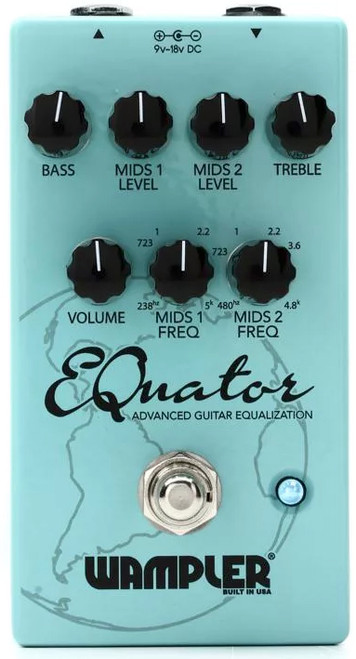The Dual Fusion pedal from Wampler Pedals is, we think, the first overdrive pedal specifically voiced to the new breed of fusion guitarists – but it’s so versatile it can find a place on ANY board of ANY genre.
Fusion in its current form is a fairly new concept, with roots not only in theoretical jazz but rock; not classic blues based rock, but the more technically advanced “shredders” that first became popular in the mid to late 80’s. One of the forerunners of this genre is Tom Quayle. Tom is the UK’s finest and most in demand exponent of modern fusion. With a rich theoretical knowledge, a student base that contains not only “regular” players but also some absolute stellar names in the industry, and a pair of ears that are completely unforgiving he has never been able to locate a pedal he can use that allows him to be the guitarist he truly is.
When we first met Tom in early 2012, he was already using our Euphoria and Paisley Drive stacked together to give him the tones he required. But, something wasn’t quite right; those pedals are voiced for other genres of music altogether so we set about honing the tones to match his style of playing. He needed more transparency, a tighter and controlled response on the bass end and when stacked up they needed to sound and feel like an amp running at high levels and give each string complete clarity and response.
Over a year later, we had the Dual Fusion. With two independent circuits that are based, but are completely modified, on the Euphoria and Paisley Drive, Tom finally has a tone that can be used when he is in full flow as a musician.
The Wampler Pedals Dual Fusion, the first pedal to be specifically voiced for the fastest growing breed of musicians around. With the most versatile stacking/signal path options available on an analog pedal, it is the foundation of modern Fusion… Add in the versatility you expect from Wampler Pedals, the Dual Fusion will appeal to guitarists from all genres at all levels.
Choosing “stacked” vs. “separate” channel switching
The toggle switch has 3 settings: 2>1, Separate, and 1>2.
Looking at the top of the pedal, the input jacks are on the right side (with an arrow pointing towards the knobs) and the output jacks are on the left side (with an arrow pointing away from the knobs). C1 means “channel 1” and C2 means “channel 2” on the jacks.
When in 2>1 mode and both channels are “on”, the guitar is routed into channel 2, then channel 1. The input cable from the guitar needs to be moved to the “C2” input jack, and the output cable to the amp needs to be moved to “C1” output jack. When in 1>2 mode and both channels are “on”, the guitar is routed into channel 1, then channel 2. The input cable from the guitar needs to be moved to the “C1” input jack and the output cable to the amp needs to be moved to the “C2” output jack. When the toggle is in the middle it is in “separate” mode, and the pedal can be used as two individual pedals, both with its respective input and output jack.
Please note that if the cables are not in the correct place, the toggle switch and effect will not work properly, but no damage is done.
















